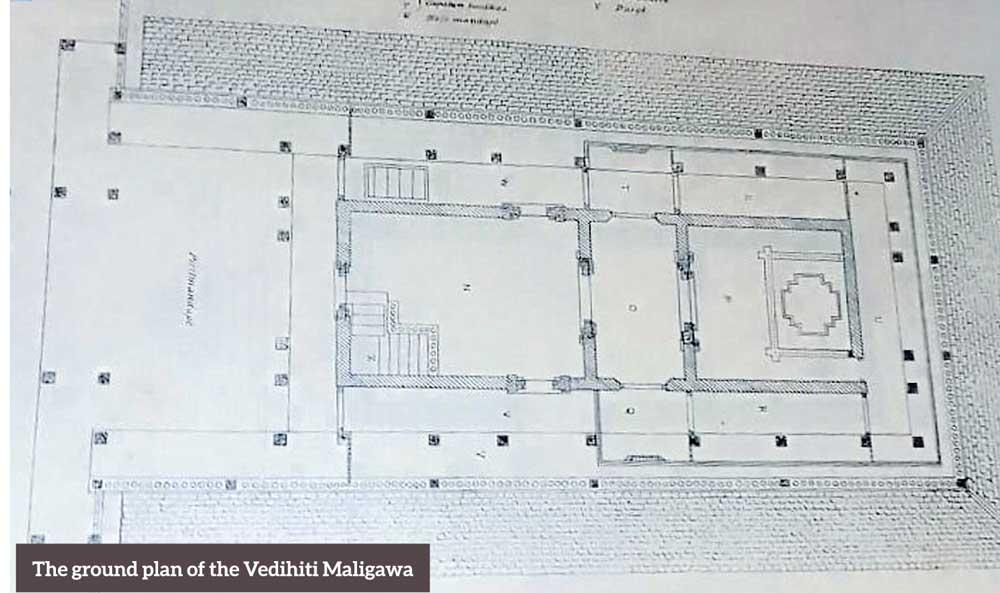29 Aug 2024 - {{hitsCtrl.values.hits}}

By L.B. Senarane
|
The elephant on the wall near the flight of steps to the Royal entrance |
Can Artificial Intelligence (AI) be used to unravel the age of the painting, that came to light with the 1998 bomb blast by the LTTE at the ‘Vadhitisanaya’ or the building where the Sacred Tooth Relic is now enshrined?
Recently AI was used on The Cloth of Turin, and their records show that it was the cloth that was used to wrap the body of Jesus Christ 2000 years ago.
There is a Sinhalese saying that ‘Something good comes from the bad’ and this is exactly what has come about at the Sri Dalada Magligawa (Temple of the Tooth) - the Palladium of the Buddhist World.
Unfortunately, no one has gone beyond the finding of this enviable painting done by an unknown artist.
If not for the explosion, a colourful chapter of the history of the Maligawa (temple) would have been hidden for centuries or would never have been found. Though it was found, no one has proceeded further to find its history. Today it has a cover to protect it.
The explosives ignited before they could be directed at the Maligawa during the terrorist attack. The explosion had a major impact on the Inner Shrine Room of the Temple.
The explosion caused damage to the plaster of the Inner Shrine Room; exposing the work of the artist.
The painting on the wall is visible when one moves onto the wooden steps at the entrance to the inner shine room. This passage is used by monks and VIP visitors.
The Center ‘Vadhitisanaya’ built with wattle and daub withstood the attack; except for the plaster that peeled at various points.
The central building, which is a restricted area, is used by the servers, the ‘Lekam’, the Diyawdana Nilame and ‘high officials’ of the temple.
After The Royal Entrance is the flight of wooden steps that leads to ‘The Sandum Kudama’ or the sandalwood room where the large bowls and ivory tusks are placed.
Conservationist Ananda Colombage, who had been involved in the conservation of the Maligawa after the blast, had been able to ascertain to a certain extent the period of the painting. It belongs either to the time of Sri Veera Parackrama Narendrasinghe (1707-1739) or King Kirthi Sri Rajasinghe (1747- 1786).
According to Colombage the painting had been done using ‘the tempura’ method which depicts the elephant with flowers and a dancer in procession. He also referred to other faintly visible paintings.
Going further, one has to depend on the Asgiri Talpata – the history of Asgiri Maha Vihare, though some may dispute this document.
A plan of the temple now in the Museum in Holland- drawn in 1602- depicts the old and new shrines. This shrine is further away towards the end of the present administrative building which is now the new wing of the Sri Dalada Maligawa. It has to be borne in mind that the Sacred Tooth Relic was not placed in the present seven caskets or ‘Karandus’. It was the personal property of the King who ruled the country. He alone worshiped the Relic and it was not shown to the public.
But due to the wars that had prevailed during that time, the old shrine may not have been in use, according to sources.
The question is whether the present shrine was built on the foundation of the original shrine or on a different foundation.
The answer lies in the fascinating elephant in the Sandum Kudama.
Colombage is of the view that the elephant in the Sandum Kudama would have been a part of the pageant.
Late Prof. Warkawe Dhammaloka Thera, who was residing at the Natha Devale Vihare, was of the view that the begging bowl of Gautama Buddha would have been around the Sri Dalada Maligawa complex.
However, several years later, fragments of a begging bowl of the Buddha was supposed to have been found in India.
Whatever the outcome, no one has taken the trouble to study the history of the Sri Dalada Maligawa after the finding of the elephant at the Vedihiti Maligawa to ascertain facts. Researchers are depending on old theories and foreign writers, but never have they put the finds together for public consumption.
27 Dec 2024 2 minute ago
27 Dec 2024 14 minute ago
27 Dec 2024 18 minute ago
27 Dec 2024 22 minute ago
26 Dec 2024 9 hours ago